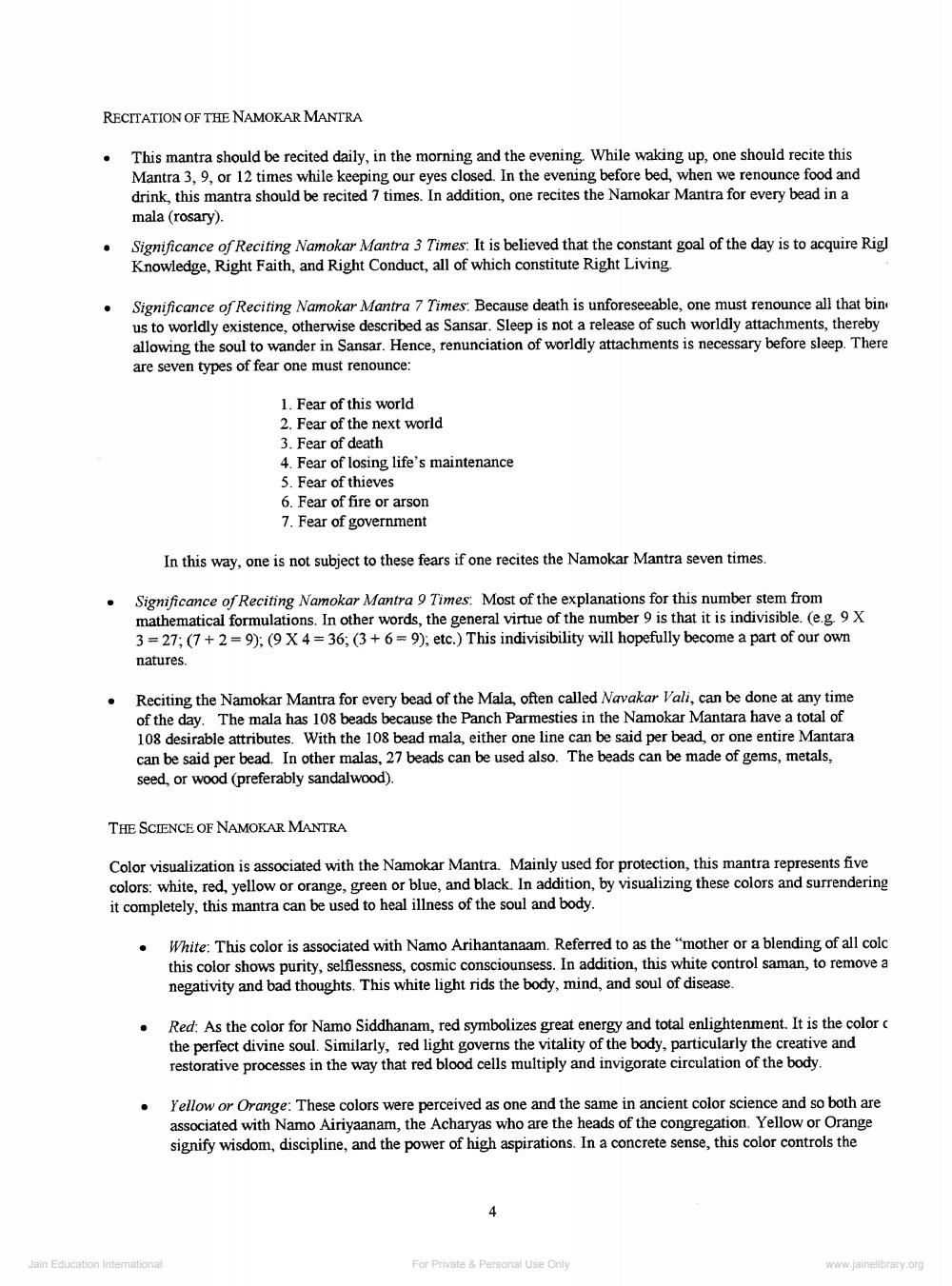________________
RECITATION OF THE NAMOKAR MANTRA
This mantra should be recited daily, in the morning and the evening. While waking up, one should recite this Mantra 3, 9, or 12 times while keeping our eyes closed. In the evening before bed, when we renounce food and drink, this mantra should be recited 7 times. In addition, one recites the Namokar Mantra for every bead in a mala (rosary) Significance of Reciting Namokar Mantra 3 Times: It is believed that the constant goal of the day is to acquire Rig] Knowledge, Right Faith, and Right Conduct, all of which constitute Right Living
Significance of Reciting Namokar Mantra 7 Times. Because death is unforeseeable, one must renounce all that bin us to worldly existence, otherwise described as Sansar. Sleep is not a release of such worldly attachments, thereby allowing the soul to wander in Sansar. Hence, renunciation of worldly attachments is necessary before sleep. There are seven types of fear one must renounce:
1. Fear of this world 2. Fear of the next world 3. Fear of death 4. Fear of losing life's maintenance 5. Fear of thieves 6. Fear of fire or arson 7. Fear of government
In this way, one is not subject to these fears if one recites the Namokar Mantra seven times.
Significance of Reciting Namokar Mantra 9 Times: Most of the explanations for this number stem from mathematical formulations. In other words, the general virtue of the number 9 is that it is indivisible. (eg 9X 3=27; (7+2 -9); (9 X 4 = 36; (3 + 6 = 9), etc.) This indivisibility will hopefully become a part of our own natures.
Reciting the Namokar Mantra for every bead of the Mala, often called Navakar Vali, can be done at any time of the day. The mala has 108 beads because the Panch Parmesties in the Namokar Mantara have a total of 108 desirable attributes. With the 108 bead mala, either one line can be said per bead, or one entire Mantara can be said per bead. In other malas, 27 beads can be used also. The beads can be made of gems, metals, seed, or wood (preferably sandalwood).
THE SCIENCE OF NAMOKAR MANTRA
Color visualization is associated with the Namokar Mantra. Mainly used for protection, this mantra represents five colors: white, red, yellow or orange, green or blue, and black. In addition, by visualizing these colors and surrendering it completely, this mantra can be used to heal illness of the soul and body,
White: This color is associated with Namo Arihantanaam. Referred to as the mother or a blending of all colc this color shows purity, selflessness, cosmic consciounsess. In addition, this white control saman, to remove a negativity and bad thoughts. This white light rids the body, mind, and soul of disease.
Red: As the color for Namo Siddhanam, red symbolizes great energy and total enlightenment. It is the color the perfect divine soul. Similarly, red light governs the vitality of the body, particularly the creative and restorative processes in the way that red blood cells multiply and invigorate circulation of the body.
Yellow or Orange: These colors were perceived as one and the same in ancient color science and so both are associated with Namo Airiyaanam, the Acharyas who are the heads of the congregation. Yellow or Orange signify wisdom, discipline, and the power of high aspirations. In a concrete sense, this color controls the
Jain Education Intemational
For Private & Personal Use Only
www.jainelibrary.org




